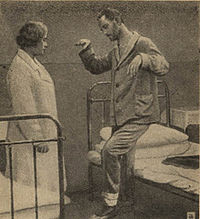
Photo from wikipedia
Dear Editor, We thank Denysenko and Sagot for their comments on our article [1]. The authors suggest that postoperative pediatric cerebellar mutism syndrome (PPCMS) may have features of catatonia and… Click to show full abstract
Dear Editor, We thank Denysenko and Sagot for their comments on our article [1]. The authors suggest that postoperative pediatric cerebellar mutism syndrome (PPCMS) may have features of catatonia and that involvement of the dentate-thalamocerebral (DTC) pathway may underlie the pathophysiology of the two disorders. Catatonia is a complex syndrome characterized by a wide spectrum of speech, motor and behavior disturbances; according to the fifth Diagnostic and Statistical Manual of Mental Disorder (DSM-V), a diagnosis of catatonia can be made if at least 3 out of the following 12 conditions are observed: mutism, stupor, cataplexy, waxy flexibility, agitation, negativism, posturing, mannerisms, stereotypes, grimacing, echolalia or echopraxia [2]. However, several other neurological and neuropsychiatric signs and symptoms can be encountered in a catatonic patient [3], thus generating clinical overlap with a number of conditions such as extrapyramidal side effects, neuroleptic malignant syndrome, non-convulsive status epilepticus, locked-in syndrome, vegetative state, stiff person syndrome and akinetic mutism [4]. As we described [1], our patient manifested a complex neurological syndrome that certainly included, but was not limited to, some features of catatonia (i.e., stupor, mutism, rigidity). Although none of us is fully experienced in the diagnosis and treatment of catatonia, we all believe that it is more correct not to use a diagnosis of catatonia when referring to our case in order to avoid confusion in terms of the etiology and prognosis with PPCMS. Notably, other authors suggested that catatonia is a symptom or a syndrome with various etiologies rather than a single entity [3]. At the same time, to emphasize that catatonic features may be present in PPCMS and that their pathophysiology may have common points, as discussed by Denysenko and Sagot, is certainly an interesting aspect. In fact, some of the brain regions involved in the pathophysiology of catatonia (e.g., orbitofrontal, prefrontal, parietal and motor cortex) [5] are altered in PPCMS, in which, differently from catatonia, additional involvement of the basal ganglia and cerebellum—resulting in crossed cerebellocerebral diaschisis—is observed on single photon emission computed tomography. In conclusion, these data seem to indicate that PPCMS shares some features with catatonia, but, until further studies clarify some open questions, these complex disorders should be considered distinct in terms of symptoms, etiology and pathophysiology.
Journal Title: Acta Neurochirurgica
Year Published: 2017
Link to full text (if available)
Share on Social Media: Sign Up to like & get
recommendations!